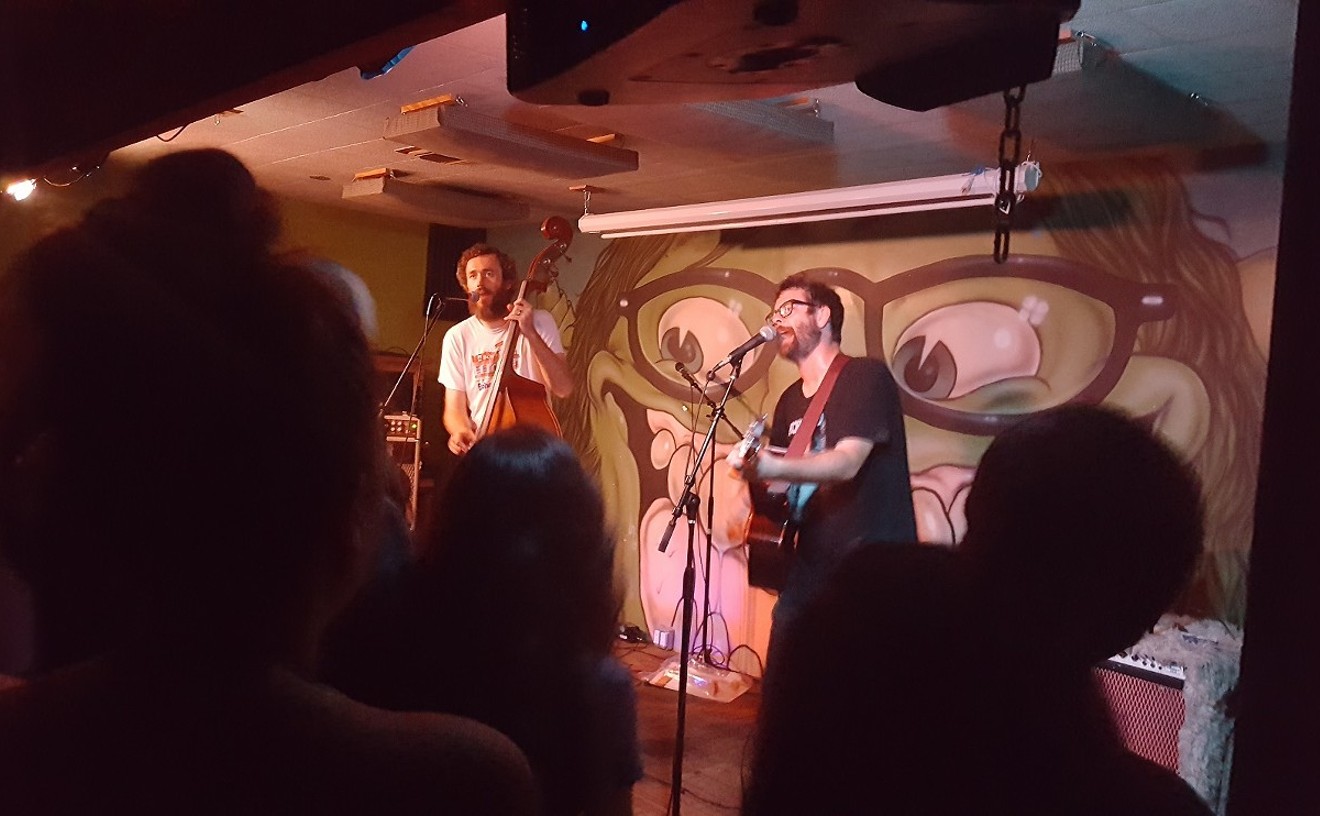Scottsdale Museum of Contemporary Art's "Pushing Paint Around: Selections from the Permanent Collection," which runs through September 7, is splashy testament to painting's longevity and continued popularity, despite the dazzling inroads of millennial electronic technology and hip experimental art forms. Yep, painting lives on, in nose-thumbing defiance of generational fads and au courant taste-makers who decree exactly what we should look at, use, and value at any given moment in history.
SMOCA's "Pushing Paint Around" showcases the primordial interaction between contemporary artist and classic art medium in large-scale works that, for the most part, morph internally from abstract to representational, then to everything in between. The work included in the exhibition underscores paint's eternal seductiveness and sensuality, no matter how abusively it is treated, not to mention its ability to transmute into a thousand different forms and appearances. Dare I say it: Working with paint has got to be as physically engrossing and emotionally satisfying as peeling sunburned skin.
This exhibition is also the first time I've seen the use of exhibition cell phone guides, which apparently are the poor man's (or poor museum's) answer to the usual Acoustiguide. Wall texts invite you to call a local number and listen to each artist talk about their particular piece — which is a great idea if you have lots of unused cell phone minutes you want to squander and, if you're from out of state, aren't slammed with roaming charges.
Take a moment from speed-dialing to look at the back wall at one of the oldest pieces in the show, Patterns — Composition #2 by Roland Bernier, which dates to 1963, making it a work by a second-generation American Abstract Expressionist. According to Bernier, his painting, which smacks of Jackson Pollock's drip-and-slash technique, began as a pattern of letters and numbers, over which he painted repeatedly, utterly destroying any representational association attached to these symbols. Ultimately, Bernier made a career out of painting words, then obliterating them repeatedly, though this early painting condenses the energy and emotionality traditionally attached to AbEx work.
The pure allure of color to painters is evident in Eve #2 (1998) by Mexican painter Ricardo Mazal. It's an enormous oil on linen featuring searing red, rib-like structures through which one can just barely spy tranquil patches of blue and golden space. By dripping, slashing, and scraping paint, Mazal's abstracted imagery echoes the psychological intensity of being imprisoned in one's own body, then freed into the calm of an open future. Using similar techniques and adding to the technical repertoire is Tucson artist Jim Waid, who scores big with Blackhaw (1992), a deliciously complex amalgam of vaguely botanical forms that shimmer and writhe. Waid's canvas, like a cake, is thickly frosted with paint in places; slashes of black applied over other areas of color are broken by combing the paint, resulting in undulating streams of striation. Oozy patches give way to scumbled and scratched-on color, while juicy touches of purple, fuchsia, yellow orange and hot pink vie for attention with a red and white stripe that snakes across the painting's upper right corner.
Much more precise, but equally intriguing is Jim Long's Hanuman (Night) (2000), which was inspired in equal parts by the mighty monkey deity of the Hindu epic Ramayana and Long's interest in fractal art, which is based on theories of fractal geometry, chaos theory and complexity theory. According to theorist Benoit Mandelbrot, a fractal is usually "a rough or fragmented geometric shape that can be split into parts, each of which is (at least approximately) a reduced-size copy of the whole." Ignoring the mathematics, the upshot is beautiful patterns which can be geometric or random, or both. Long's Hanuman, executed in thin paint layers, suggests three-dimensional microbial forms, as well as astronomical constellations.
The real star of the show, however, is Terrence LaNoue's Gemstone: Strange Fruit, produced between 1989 and 1990, in which he pits teeming biomorphic shapes against hard-line geometric forms. An ominous form suggestive of saggy grapes (or, perhaps, it's intestinal material) in various colors and differing paint depths serves as a focal point, which dead-ends into passages of curvilinear and geometric shapes that hover over a narrow stripe mimicking stonework. In places, LaNoue has slathered paint so thickly that it cracks and alligators, just begging to be peeled or pried away.
It's nice to see that two local Phoenix artists have been included in "Pushing Paint Around," one of whom holds his own against the more recognized painters in the show. Randy Slack's Seventeen Pussy Cat Cover Up by Banana Leaf Still Life (2002) is the artist's irreverent take on his somewhat seedy downtown Phoenix studio life. It features a midcentury motel sign with swooping arrow, kitschy '50s style girls, cartoon cats, graffiti and drippy paint, all overlaid with a yellow outline of three undeniably phallic bananas. Unfortunately, Sue Chenoweth's Fragile Like Foliage (2002), an acrylic, graphite, ink, and Letraset painting on wood, just isn't up to her usual output and suffers from over-intellectualizing. Not only is it the smallest piece in a forest of gigantic paintings, but it also lacks Chenoweth's characteristically edgy emotional fire and frenzied brushwork, two crucial ingredients that make her work some of the most exciting being produced in the West today.










